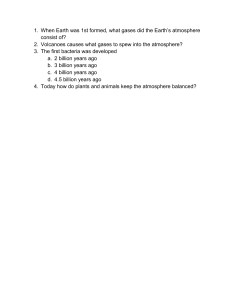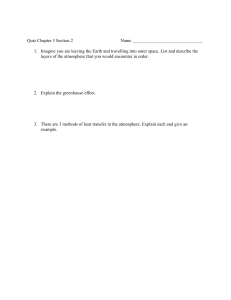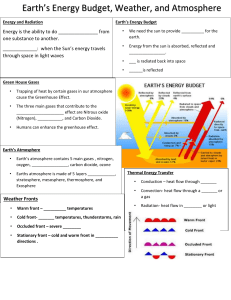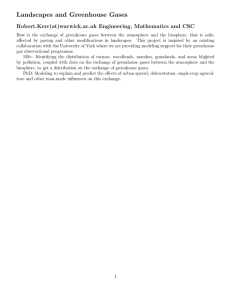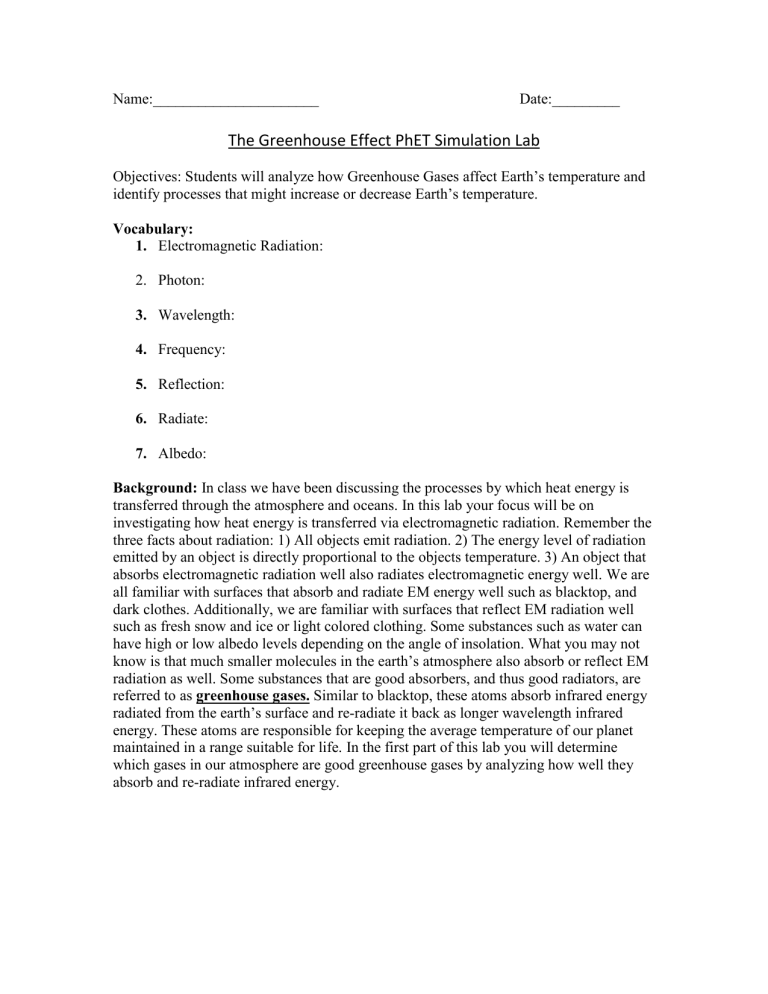
Name:______________________ Date:_________ The Greenhouse Effect PhET Simulation Lab Objectives: Students will analyze how Greenhouse Gases affect Earth’s temperature and identify processes that might increase or decrease Earth’s temperature. Vocabulary: 1. Electromagnetic Radiation: 2. Photon: 3. Wavelength: 4. Frequency: 5. Reflection: 6. Radiate: 7. Albedo: Background: In class we have been discussing the processes by which heat energy is transferred through the atmosphere and oceans. In this lab your focus will be on investigating how heat energy is transferred via electromagnetic radiation. Remember the three facts about radiation: 1) All objects emit radiation. 2) The energy level of radiation emitted by an object is directly proportional to the objects temperature. 3) An object that absorbs electromagnetic radiation well also radiates electromagnetic energy well. We are all familiar with surfaces that absorb and radiate EM energy well such as blacktop, and dark clothes. Additionally, we are familiar with surfaces that reflect EM radiation well such as fresh snow and ice or light colored clothing. Some substances such as water can have high or low albedo levels depending on the angle of insolation. What you may not know is that much smaller molecules in the earth’s atmosphere also absorb or reflect EM radiation as well. Some substances that are good absorbers, and thus good radiators, are referred to as greenhouse gases. Similar to blacktop, these atoms absorb infrared energy radiated from the earth’s surface and re-radiate it back as longer wavelength infrared energy. These atoms are responsible for keeping the average temperature of our planet maintained in a range suitable for life. In the first part of this lab you will determine which gases in our atmosphere are good greenhouse gases by analyzing how well they absorb and re-radiate infrared energy. Directions: Follow the procedures below to complete this online lab. All questions are in italicized and must be completed. Use complete sentences when appropriate and show all work for any calculations. Procedures: 1. Go to: http://phet.colorado.edu/en/simulation/greenhouse. 2. Click on RUN NOW. 3. Maximize the window and select the “Photon Absorption” tab from the top of the screen. 4. Familiarize yourself with the simulation. The Atmospheric Gases are listed on the right. Questions (RT1) 1. What percentage of the Earth’s atmosphere is composed of Nitrogen gas (N2)?______ 2. What percentage of the Earth’s atmosphere is composed of Oxygen gas (O2)?_______ 3. According to the simulation, list the three of the gases that compose the other 1 %. 1. __________ 2. __________ 3. __________ 5. There are two types of photons (particles of light) used in this simulation, Visible and Infrared. Select the visible photon first. HYPOTHESIS: Based on our class notes, predict which gases in the earth’s atmosphere will absorb/re-radiate the most visible light energy. Rank each gas on a scale from 1-5 with 1 absorbing/re-radiating the most and 5 absorbing/re-radiating the least. Provide a brief explanation for your prediction. 6. To analyze how well each atmospheric gas absorbs and re-radiates visible energy, fire 50 photons(set the slider on the gun higher to fire at a rate you can observe) at each gas and calculate the percentage of photons absorbed and re-radiated. To calculate percentages use the following formula and fill in Table 1 on the next page: % photons absorbed and re-radiated=photons absorbed and re-radiated x 100 Photons fired Table 1 Visible Energy Absorption of Atmospheric Gases Atmospheric Gas % Photons Absorbed % Photons Transmitted CH4 CO2 H2O N2 O2 Questions: 4. Were your hypotheses supported? Explain why you shouldn’t be surprised at the results. (Hint: If the gases of the earth’s atmosphere absorbed and re-radiated visible light, what would we see?) 5. What can you conclude about the transparency of the earth’s atmosphere with regards to visible energy? 6. Compare the wavelength, frequency and energy levels of visible light energy and infrared energy. HYPOTHESIS: Based on your prior knowledge, predict which gases in the earth’s atmosphere will absorb and re-radiate the most infrared energy. Rank each gas on a scale from 1-5 with 1 absorbing and re-radiating the most and 5 absorbing/re-radiating the least. Provide an explanation for your prediction. 7. To analyze how well each atmospheric gas absorbs and re-radiates infrared energy, fire 50 photons(set the slider on the gun higher to fire at a rate you can observe) at each gas and calculate the percentage of photons absorbed and re-radiated. Fill in Table 2 below: Table 2 Infrared(Heat) Energy Absorption of Atmospheric Gases Atmospheric Gas % Photons Absorbed % Photons Transmitted CH4 CO2 H2O N2 O2 Questions: 7. Was your hypothesis supported? Rank each gas on its absorption and re-radiation ability from 1-5 based on your results. 1 is best absorber and re-radiator and 5 are worst. 8. Based on the results which gases contribute the greatest to warming the earth’s atmosphere? Do these gases make up a large percentage of the earth’s atmosphere? Be specific. 9. Evidence from many scientific disciplines has shown that the earth’s climate is experiencing a warmer trend. The addition, of which of these gases, has contributed to the greatest increase in global temperatures? What are some of the anthropogenic (human made) sources of this greenhouse gas? 10. Based on the results of this part of the lab, describe (using the terms in the vocabulary section) how increases in greenhouse gases such as CO2 and Methane( CH4) can lead to a warming of the earth’s atmosphere. Part 2- The Greenhouse Effect- Past and Present 1. Select the “Greenhouse Effect” tab from the top of the simulation. 2. Add one cloud to the simulator 3. Observe the simulation and answer the following: Questions 1. There are two types of photons in the simulation. What type of electromagnetic radiation does the Sunlight Photon represent? 2. Which type of radiation has a shorter wavelength and therefore a higher energy level. 3. Which type of photon represents heat energy being transferred through the atmosphere? 4. Which type(s) of photons are absorbed by the Earth’s surface? 5. Which type (s) of photons is radiated by the Earth’s surface? 6. Describe at least 2 things that can happen to a photon of visible light(sunlight photon) as it makes its trip to the earth’s surface. Be specific and use terms from Part 1. (Hint: you may need to watch the simulation for a minute or so) 7. Identify 2 things that can happen to a photon of infrared light as it makes its trip through the earth’s atmosphere. Be specific and use terms from Part 1. 8. Why do you think some of the infrared photons appear to be reradiated back toward earth’s surface as they travel up through the atmosphere? How might this re-radiation affect the surface temperature of the earth? 4. Select “Ice Age” from the Atmosphere during box on the right side of the simulator. Notice a new gas appears (N2ONitrous Oxide) Ice Age 1. Click on the “Ice Age” button and run the simulation run for a minute or two. Carefully watch the temperature and record the minimum temperature. ______ 2. Record: CO2 _____ CH4 _____ N2O _____ 3. What happens to the sunlight photons as they hit the ground? 4. What happens to the sunlight photons as they strike the ice? 5. What happens to the temperature when you add clouds? 6. Describe how are the photons are affected by adding clouds? 5. Select 1750 from the Atmosphere during box on the right side of the simulator 1750 1. Click on the “1750” button and record the minimum temperature. _______ 2. Record: CO2 _____ CH4 _____ N2O _____ 3. How has the concentration of greenhouse gases changed from the ice ages to the 1750’s? How much has the average temperature risen as a result of these additional greenhouse gases? 6. Select Today from the Atmosphere during box on the right side of the simulator 1. Click on the “Today” button and record the minimum temperature. _______ 2. Record: CO2 _____ CH4 _____ N2O _____ CONCLUSIONS In a paragraph, summarize how the Greenhouse Gases affected Earth’s atmosphere during the Ice Age, the year 1750 and Today. Predict what would happen to the Earth’s temperature if there were no Greenhouse gases? Adjust the Greenhouse Gas Concentration Level to None and test your prediction. Were you correct? What was earth’s average temperature with no greenhouse gases. Predict what would happen to earth’s average temperature if Greenhouse Gas levels increased? Adjust the Greenhouse Gas Concentration Level to Lots. Describe what happens to the earth‘s average temperature. Identify 2 natural and 2 human processes that might increase or decrease the amount of greenhouse gases in the atmosphere.
